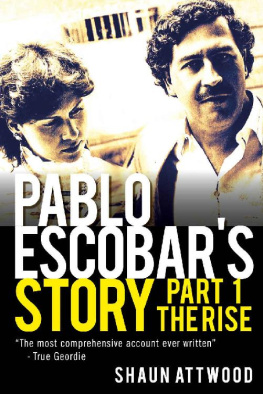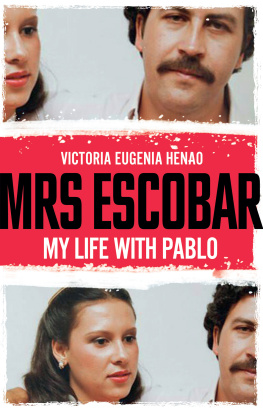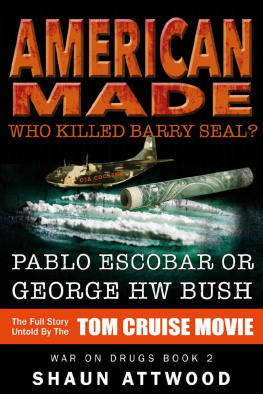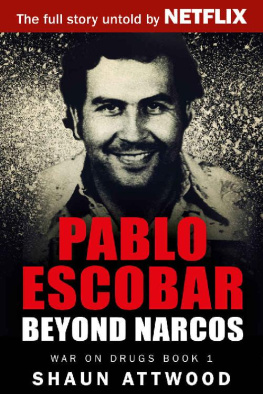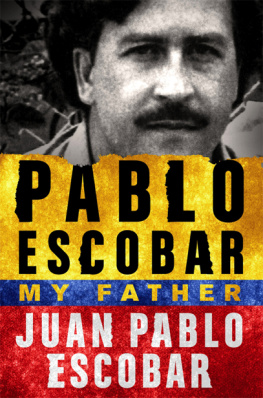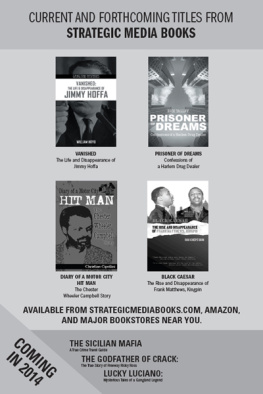Pablo Escobars Story 3:
Narcos Fall
Shaun Attwood
First published in Great Britain by Gadfly Press in 2020
Copyright Shaun Attwood 2020
The right of Shaun Attwood to be identified as the author of this work has been asserted by him in accordance with the Copyright, Designs and Patents Act 1988. All rights reserved
No part of this book may be reproduced, stored in a retrieval system or transmitted in any form or by any means (electronic, mechanical, photocopying, recording or otherwise) without the prior written permission of the author, except in cases of brief quotations embodied in reviews or articles. It may not be edited, amended, lent, resold, hired out, distributed or otherwise circulated without the publishers written permission
Permission can be obtained from
This book is a work of non-fiction based on research by the author
A catalogue record of this book is available from the British Library
Typeset and cover design by Jane Dixon-Smith
Acknowledgements
A big thank you to Mark Swift (editing) and Jane Dixon-Smith (typesetting and book-jacket design)
Spelling Differences: UK v USA
This book was written in British English, hence USA readers may notice some spelling differences with American English: e.g. color = colour, meter = metre and = jewelry = jewellery
Shauns Books
English Shaun Trilogy
Party Time
Hard Time
Prison Time
War on Drugs Series
Pablo Escobar: Beyond Narcos
American Made: Who Killed Barry Seal? Pablo Escobar or George HW Bush
The Cali Cartel: Beyond Narcos
Clinton Bush and CIA Conspiracies: From The Boys on the Tracks to Jeffrey Epstein
Un-Making a Murderer: The Framing of Steven Avery and Brendan Dassey
The Mafia Philosopher: Two Tonys
Life Lessons
Pablo Escobars Story (4-book series)
Social-Media Links
Email:
YouTube: Shaun Attwood
Blog: Jons Jail Journal
Website: shaunattwood.com
Instagram: @shaunattwood
Twitter: @shaunattwood
LinkedIn: Shaun Attwood
Goodreads: Shaun Attwood
Facebook: Shaun Attwood, Jons Jail Journal, T-Bone Appreciation Society
Shaun welcomes feedback on any of his books.
Thank you for the Amazon and Goodreads reviews!
Contents
Intro
Many authors have tried to dissect Pablos character, with each only providing a few pieces of the puzzle. The first Escobar book I wrote was part of a series exposing the War on Drugs. Since its publication, Ive received requests to write his biography in more detail and without the War on Drugs politics. This new series of books containing approximately 1,000 pages is my response.
After doing a talk about Pablo in London, I was approached by a Colombian. She said that there was far more information available about him in the Spanish-speaking world. On a mission, I ended up getting hundreds of thousands of words translated, which transformed my understanding of his story. Previously, I had viewed him through the filters of the English-speaking world and many of those authors had an agenda such as portraying certain people or government agencies in particular ways.
This book also includes everything I have learned about El Patrn while researching information for my books on the Cali Cartel and Barry Seal. Since the explosion of interest in Pablo, far more up-to-date information has become available thanks to those closest to him who later became authors, including his wife, Victoria Eugenia Henao ( Mrs Escobar: My Life with Pablo ); his ex-lover and TV celebrity, Virginia Vallejo ( Loving Pablo, Hating Escobar ); his son, Juan Pablo ( Pablo Escobar: My Father ); and his former hit man, Popeye ( The True Life of Pablo Escobar and Surviving Pablo Escobar ) who was released after serving 23 years, started a popular YouTube channel, but was arrested for extortion and died from oesophageal cancer on February 6, 2020 in Bogot, aged 57. Two of the men chiefly responsible for Pablos demise, Don Berna ( Killing the Boss ) and Carlos Castao ( My Confession ), also published books about their roles, which contradicted the official story of the police killing Pablo. In Secret ( En Secreto ) by the journalist Germn Castro Caycedo and The Words of Pablo ( La Parbola de Pablo ) by Alonso Salazar also contain lots of information.
These combined accounts helped to revise my earlier versions of the big stories such as the absence of Los Pepes at Pablos death, and the role of the state in the murder of the presidential candidate Galn, which had largely been overlooked. In 2017, Pablos nemesis, General Maza, was sentenced to thirty years for conspiring to murder Galn, which had been squarely blamed on Pablo by most authors. This book also contains stories untold in the English-speaking world. It is my hope that I have provided the most detailed and up-to-date account.
Chapter 1
Final Elite Kidnappings
Diana Turbay the daughter of ex-president Julio Csar Turbay Ayala was a brunette with kind eyes and a magnetic personality. In August 1990, she was invited to interview a priest who was part of a guerrilla group called the National Liberation Army. Due to the risks, her friends and family warned her not to go, but she was not the type to shrink from danger if good could be achieved. She had once travelled into guerrilla territory on a mule, hoping to gain an understanding of their motivations. To help the peace process along, she had visited a camp to meet an M-19 leader who had once attempted to kill her father by firing a rocket at his room. If interviewing the priest would make things safer for Colombia, she would gladly risk her life.
On August 30, a beat-up van arrived in Bogot to take Diana and her crew to the priest. Two young men and a woman emerged, claiming they were part of the guerrilla leadership. West of Bogot, they switched from the van to two other vehicles. After eating at a tavern, they took a dangerous road in heavy rain, and had to stop at dawn until a landslide was cleared.
After a sleepless night, they met a patrol with five horses at 11 AM. For four hours, Diana rode on a horse, while most of the group trekked through mountain forest and a valley with houses nestled into coffee groves. Recognising Diana from the TV, some of the locals yelled greetings. In the evening, they arrived at a deserted ranch near a highway, with a view of Medelln. A young man said he was with the guerrillas but offered no more information. Perplexed as to why they werent in guerrilla territory yet, they consoled themselves with the likelihood that the priest wanted to meet them in the least obvious place as a precaution.
After two hours, they stopped in Copacabana, at a small house with white walls, its roof tiles green from moss. Diana and a female companion were given the best room at the back; as its windows were boarded over, a light was kept on. The guards didnt have the usual weapons used by the guerrillas. One was even wearing a Rolex.
Three hours later, a masked man greeted them on behalf of the priest. He said that for security, the women should travel to the priest first. Getting split from her male colleagues troubled Diana. One of them whispered that she shouldnt go anywhere without them. With alarm in her eyes, she gave him her ID.
Before sunrise, the women were moved to a bigger house. Her male companions arrived on September 10, 1990. Diana confided that she was depressed over having led them into what she suspected was a trap. She said that she didnt fear for herself, but if anything happened to her colleagues, she wouldnt find any peace. Throughout the night, she was kept awake by thoughts of what her husband, children and parents were going through. The next night, she and two female colleagues were forced to trudge along a path in the rain.





